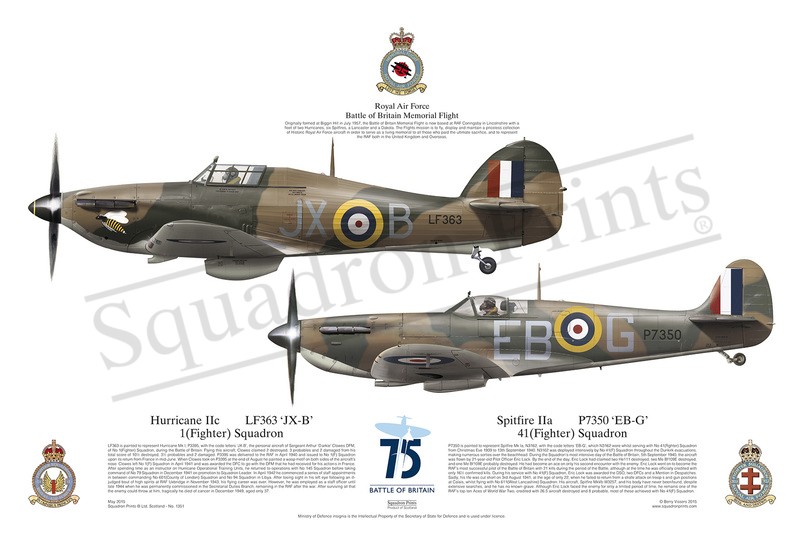#1351 Hurricane IIc

Purchased products will not feature the Squadron Prints watermark
Description
Squadron Prints Lithograph No. 1351 - Hurricane IIc, LF363 'JX-B', 1(Fighter) Squadron and Spitfire IIa, P7350 'EB-G', 41(Fighter) Squadron.
LF363 is painted to represent Hurricane Mk I, P3395, with the code letters ‘JX-B’, the personal aircraft of Sergeant Arthur ‘Darkie’ Clowes DFM, of No 1(Fighter) Squadron, during the Battle of Britain. Flying this aircraft, Clowes claimed 2 destroyed, 3 probables and 2 damaged from his total score of 10½ destroyed, 3½ probables and 2 damaged. P3395 was delivered to the RAF in April 1940 and issued to No 1(F) Squadron upon its return from France in mid-June. When Clowes took on P3395 at the end of August he painted a wasp motif on both sides of the aircraft’s nose. Clowes left No 1(F) Squadron in April 1941 and was awarded the DFC to go with the DFM that he had received for his actions in France. After spending time as an instructor on Hurricane Operational Training Units, he returned to operations with No 145 Squadron before taking command of No 79 Squadron in December 1941 on promotion to Squadron Leader. In April 1942 he commenced a series of staff appointments in between commanding No 601(County of London) Squadron and No 94 Squadron in Libya. After losing sight in his left eye following an ill-judged bout of high spirits at RAF Uxbridge in November 1943, his flying career was over. However, he was employed as a staff officer until late 1944 when he was permanently commissioned in the Secretarial Duties Branch, remaining in the RAF after the war. After surviving all that the enemy could throw at him, tragically he died of cancer in December 1949, aged only 37.
P7350 is painted to represent Spitfire Mk Ia, N3162, with the code letters ‘EB-G’, which N3162 wore whilst serving with No 41(Fighter) Squadron from Christmas Eve 1939 to 13th September 1940. N3162 was deployed intensively by No 41(F) Squadron throughout the Dunkirk evacuations, making numerous sorties over the beachhead. During the Squadron’s most intensive day of the Battle of Britain, 5th September 1940, the aircraft was flown by 21-year-old Pilot Officer Eric Lock. By the end of the day, Eric Lock had claimed two He111 destroyed, two Me Bf109E destroyed, and one Me Bf109E probably destroyed. He had become an ace on only his second encounter with the enemy. Eric Lock went on to become the RAF’s most successful pilot of the Battle of Britain with 21 kills during the period of the Battle, although at the time he was officially credited with only 16½ confirmed kills. During his service with No 41(F) Squadron, Eric Lock was awarded the DSO, two DFCs and a Mention in Despatches. Sadly, his life was cut short on 3rd August 1941, at the age of only 22, when he failed to return from a strafe attack on troops and gun positions at Calais, whilst flying with No 611(West Lancashire) Squadron. His aircraft, Spitfire MkVb W3257, and his body have never been found, despite extensive searches, and he has no known grave. Although Eric Lock faced the enemy for only a limited period of time, he remains one of the RAF’s top ten Aces of World War Two, credited with 26.5 aircraft destroyed and 8 probable, most of these achieved with No 41(F) Squadron.
You may also like
-
Spitfire and Hurricane
P7350 'QJ-G'; P7350 'QV-E'; LF363 'GN-F'; LF363 'SD-A'19 Sqn; BBMF; 92 Sqn; 249 Sqn; 501 SqnRAF Coningsby -
Tiger Moth, Harvard, Chipmunk, Bulldog, Tutor
XX525 '03'; FX213; N6720; WK640East of Scotland UASRAF Leuchars
